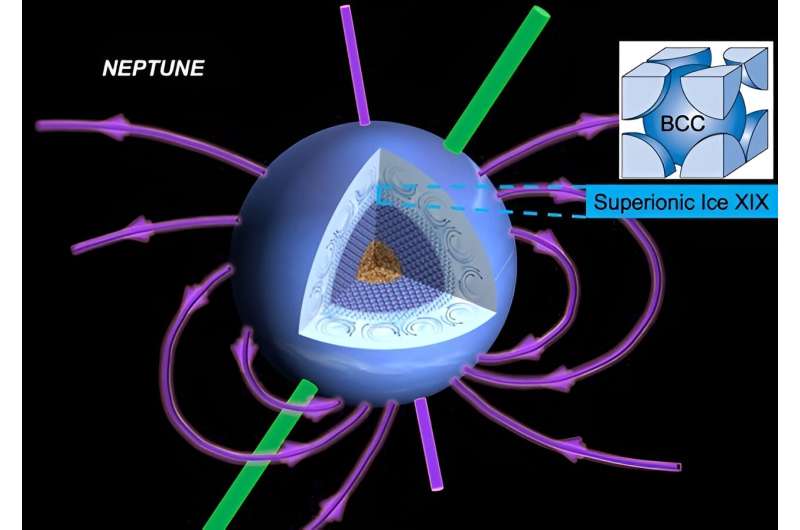This article has been reviewed according to Science X's editorial process and policies. Editors have highlighted the following attributes while ensuring the content's credibility:
fact-checked
peer-reviewed publication
trusted source
proofread
Scientists discover a new phase of high-density, ultra-hot ice

The outer planets of our solar system, Uranus and Neptune, are water-rich gas giants. These planets have extreme pressures 2 million times the Earth's atmosphere. They also have interiors as hot as the surface of the sun. Under these conditions, water exhibits exotic, high-density ice phases.
Researchers recently observed one of these phases, called Ice XIX, for the first time using high-power lasers to reproduce the necessary extreme conditions. They measured the Ice XIX structure using the Matter at Extreme Conditions instrument at the Linac Coherent Light Source, a pioneering X-ray laser facility, to show that oxygen atoms pack in a body-centered cubic structure, while the hydrogen atoms move freely like a fluid, dramatically increasing conductivity. Their paper was published in Scientific Reports.
Voyager II, a NASA solar system exploration spacecraft launched in 1977, measured highly unusual magnetic fields around Uranus and Neptune. Scientists considered exotic states of so-called superionic ice as a possible explanation due to these states' increased electrical conductivity. This work demonstrates the existence of the previously undiscovered Ice XIX phase. It shows that this phase could form at the right depths and help explain the Voyager II magnetic data.
Water, a compound that is ubiquitous in our solar system and necessary for life, exhibits an exceptionally complex pressure-temperature phase diagram with 18 crystalline ice phases already identified. Nowhere are dense ice phases more important than in the interiors of gas giants like Uranus and Neptune. Scientists hypothesize that these planets' complex magnetic fields are produced by exotic high-pressure states of water ice with superionic properties. However, the structure of ice at these extreme conditions is notoriously challenging to measure.
Using the Matter at Extreme Conditions instrument at the Linac Coherent Light Source, an ultrafast X-ray Free Electron Laser and a Department of Energy (DOE) Office of Science user facility, to probe the ice structure during laser-driven dynamic compression, researchers found the first direct evidence of a new phase of high-density, ultra-hot water ice.
At 200 GPa (2 million atmospheres) and 5,000 K (8,500°F) this new high-pressure ice phase, deemed Ice XIX, has a body-centered cubic (BCC) lattice structure. Though other structures have been theorized to be stable at these conditions, Ice XIX's BCC structure would enable an increase in the electrical conductivity much deeper into the interiors of ice giants than previously thought.
The results provide an important and compelling origin of the multi-polar magnetic fields as measured by the Voyager II spacecraft for Uranus and Neptune.
More information: A. E. Gleason et al, Dynamic compression of water to conditions in ice giant interiors, Scientific Reports (2022). DOI: 10.1038/s41598-021-04687-6
Journal information: Scientific Reports
Provided by US Department of Energy





















